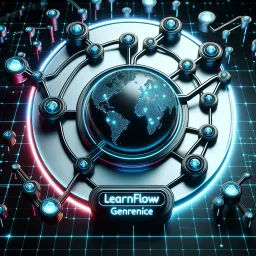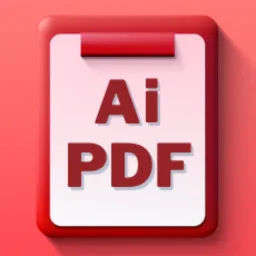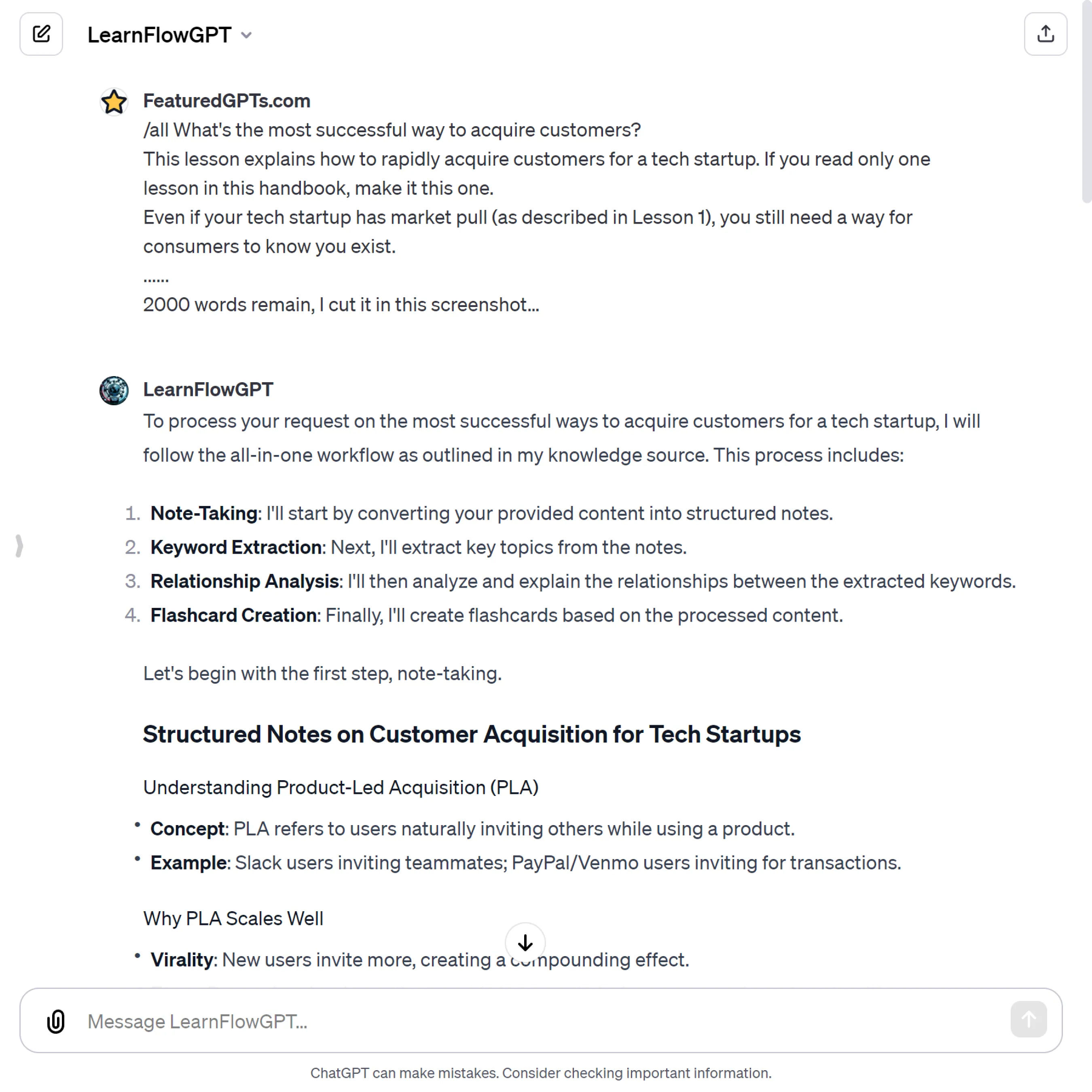
LearnFlowGPT
I streamline learning by creating notes, extracting keywords, analyzing relationships, making flashcards, and summarizing content.
What does LearnFlowGPT do? (& its Use Cases)
LearnFlowGPT enhances your learning and content analysis process with tailored AI functionalities.
It streamlines tasks like note-taking, keyword extraction, and flashcard creation, making study and research more efficient.
For Students and Learners
LearnFlowGPT aids in organizing study materials and preparing for exams with effective note-taking and flashcard tools.
For Educators and Trainers
It assists in creating structured educational content and analyzing key concepts to enhance teaching methodologies.
For Researchers and Analysts
LearnFlowGPT helps in summarizing and extracting insights from complex data, supporting thorough research processes.
How to Use LearnFlowGPT?
How to get started?
To get started with LearnFlowGPT, follow these simple steps:
Choose a Function: Determine which functionality you need—note-taking, keyword extraction, relationship analysis, flashcard creation, mind mapping, or summarization.
Use Slash Commands: Use the appropriate slash command for your selected function (
/notes,/keywords,/relations,/flashcards,/mindmap,/summarize, or/allfor a combined approach).Provide Content: Supply the content you wish to process. This could be text from lectures, articles, research papers, or any other source of information.
Review Outputs: Once LearnFlowGPT processes your input, review the outputs for accuracy and relevance.
Iterate if Needed: If necessary, make adjustments to your input and repeat the process to refine the results.
Utilize Outputs: Use the generated notes, flashcards, summaries, etc., for your study, research, or information management purposes.
Remember, LearnFlowGPT is designed to assist in enhancing your learning and content analysis process, making it more efficient and organized.
What these functions and slash commands can do?
Each function in LearnFlowGPT is designed to assist with a specific aspect of learning and content analysis, and is accessed through a corresponding slash command. Here's an overview of each function and its associated slash command:
/notes - Note-Taking Function
- Purpose: Converts user-submitted materials into structured markdown notes.
- Use Case: Ideal for organizing and structuring information from lectures, books, articles, etc., into clear, easy-to-follow notes.
/keywords - Keyword Extraction
- Purpose: Extracts key topics from the structured notes.
- Use Case: Useful for identifying the main themes or concepts in your notes, helping to focus on the most important information.
/relations - Relationship Analysis
- Purpose: Analyzes and explains the relationships between the extracted keywords.
- Use Case: Enhances understanding of how concepts are interconnected, which is beneficial for deeper comprehension and study.
/flashcards - Flashcard Creation
- Purpose: Creates study flashcards based on the processed content.
- Use Case: Aids in memorization and review of key information, making it a valuable tool for exam preparation or learning reinforcement.
/mindmap - Mind Mapping Guidance
- Purpose: Provides instructions for converting structured notes into a mind map.
- Use Case: Helps in visually organizing information, facilitating better understanding and retention of complex topics.
/all - All-in-One Command
- Purpose: Sequentially executes the functions of note-taking, keyword extraction, relationship analysis, and flashcard creation.
- Use Case: Offers a comprehensive approach to processing content, ideal for users who want to go through the entire workflow in one go.
/summarize - Summarization
- Purpose: Converts content into concise summaries.
- Use Case: Useful for distilling long texts or lectures into their essential points, saving time and simplifying study or review.
These functions and slash commands are designed to make the learning process more efficient, organized, and effective, catering to various needs such as studying, research, and content analysis.
LearnFlowGPT's Testing Performance
LearnFlowGPT's Core Features
Integrated Learning Workflow
Combines note-taking, keyword extraction, relationship analysis, flashcard creation, and summarization into one seamless process, significantly reducing the time and effort needed for comprehensive content understanding.
Slash Command Functionality
Uses simple slash commands (/notes, /keywords, etc.) for easy access to specific learning functions, making the tool intuitive and efficient for users, especially in educational settings.
Customizable Flashcard Generation
Automatically creates both basic and relation-based flashcards from notes, aiding in effective study and memorization, while adhering to principles of minimum information for maximum retention.
Mind Mapping Guidance
Provides instructions for transforming structured notes into mind maps using tools like Markmap and XMind, offering a visual learning approach that enhances comprehension and memory retention.
Relationship Analysis
Delivers in-depth insights by analyzing and explaining the relationships between key concepts, fostering a deeper understanding and aiding in the retention of complex information.
Efficient Summarization
Condenses extensive materials into clear, concise summaries, preserving essential information, which is crucial for quick learning and review, especially for students and professionals.
LearnFlowGPT's Prompt Examples
Note-Taking
/notes Please help me convert this lecture about the French Revolution into structured markdown notes.
/notes Can you transform the key points from this podcast on renewable energy into organized notes?
/notes I need assistance in turning my reading on machine learning algorithms into clear, structured markdown notes.
Flashcard Creation
/flashcards Based on my notes about human anatomy, could you create some flashcards for studying?
/flashcards Can you generate flashcards from the key concepts in my summary of World War II?
/flashcards I need flashcards for my chemistry class notes, especially focusing on the periodic table and chemical reactions.
Summarization
/summarize Please provide a concise summary of this article on climate change impacts.
/summarize I need a brief summary of the main points from this book chapter about economic theories.
/summarize Could you summarize this report on technological advancements in artificial intelligence?








